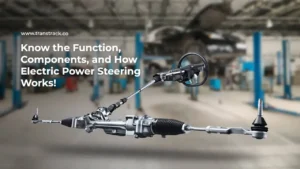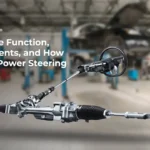Know 11 Characteristics of Used Flooded Cars that You Should Be Wary of!
Posted on August 13, 2024 by Nur Wachda Mihmidati

Buying a used car can be a smart choice to get a quality vehicle at a more affordable price. However, one of the biggest risks is buying a car that has been flooded, which can cause a variety of serious problems. Recognizing the signs of a flooded used cars is essential to avoid a costly purchase. This TransTRACK article will outline the various signs that can help you identify if the used car you are considering has experienced flood damage. With this information, you can make better decisions and protect your investment.
Is an ex-flood car safe to use?
Ex-flooded cars can present significant safety and performance risks if not carefully inspected. Water soaking a vehicle can damage electronic components, which is often not immediately apparent but can cause serious problems later on. In addition, metal parts of the car can rust and corrode due to water exposure, which can reduce the strength and safety of the vehicle. A waterlogged engine also has the potential for severe damage, such as lubrication issues or internal damage. To avoid these problems, it is important to have a thorough inspection by a trusted mechanic and check the vehicle history before deciding to buy a used car that has been flooded.
Characteristics of Used Flooded Cars to Watch Out for
The characteristics of used flooded cars that need to be watched out for include several external and internal aspects. The following are the characteristics of used flood cars that you should be aware of:
External characteristics
There are several external characteristics, namely:
Rust on the underside of the car
Rust on the underside of a car indicates prolonged exposure to water, which can damage the metal structure. This could indicate that the vehicle has been flooded and may have long-term problems.
Water or mud stains on the interior and trunk
These stains indicate that water or mud may have gotten into the cabin and trunk. This can cause problems with the interior materials and shorten the life of the vehicle.
Damp or unpleasant odor in the cabin
A damp smell in the cabin indicates moisture that is not fully removed, which can lead to mold growth and interior damage. It could also indicate a problem with the ventilation and air circulation system.
Uneven Paint Condition
Check for discoloration or uneven paint layers on the exterior. This could indicate that the car has been polished to cover flood damage. Uneven paint can be an indication that the vehicle has undergone major repairs.
Doors and Windows that are Difficult to Open or Close
Check if the doors and windows are difficult to open or close smoothly. This problem may indicate a deformation of the car frame due to structural damage caused by flooding. This could indicate that water has damaged the basic structure of the vehicle.
Bulging or Detached Carpets
Carpets in the car that bubble or detach could indicate water exposure. This condition is often seen in ex-flooded cars as carpets exposed to water may start to detach or damage the adhesive. This can be a sign that the car’s interior has been submerged in water.
Internal characteristics
There are several internal characteristics, namely:
Corroded electronic cables and connectors
Rust on cables and connectors indicates that electronic components have been exposed to water. This may result in damage to the electronic system and vehicle function problems.
Engine that is difficult to start or runs unstable
Engine problems, such as hard starting or unstable running, may be caused by internal damage due to water exposure. This can affect vehicle performance and require costly repairs.
Poorly Functioning Cooling and Air Conditioning System
If the cooling or air conditioning system is not functioning normally, it may indicate damage from water seeping into the system. Damage to this system can affect driving comfort and vehicle performance. Check for symptoms of leaks or interruptions in the cooling system.
Abnormal Oil and Fluids
Check for contamination in the engine oil or other fluids, such as cloudy color or strange odor. Oil mixed with water can reduce engine lubrication and affect vehicle performance. Abnormal fluids can indicate flood damage.
Problematic Audio System and Other Features
Check if the audio system or other electronic features are not working properly. Electronic components that are not working normally could be the result of water damage that has interfered with the circuitry or wiring. Problematic features often indicate damage from water exposure.
How to Thoroughly Inspect an Ex-Flood Car
Thoroughly inspecting an ex-flood car requires attention to several important aspects:
Check the Bottom of the Car
Check for rust or corrosion on the underside of the car and other metal components. Rust can indicate prolonged exposure to water and damage to the vehicle’s structure. If you find rust, this could be an indication that the car has been flooded.
Check the Interior and Trunk
Check for water stains, mud, or damp odors inside the cabin and trunk. These stains and odors may indicate that water or mud has entered the car’s interior. This can cause damage to the materials and shorten the life of the vehicle.
Electronics and Wiring Inspection
Check the electronic cables and connectors for signs of rust or damage. Damage to electronic components may indicate that the vehicle has been submerged in water. Damaged electronic systems can cause serious functional problems.
Test the Engine
Start the engine and notice if there is any difficulty in starting or the engine runs unsteadily. These difficulties could indicate internal damage due to water exposure. An engine that is not functioning properly may require expensive repairs.
Check Vehicle History
Ask for the vehicle’s history and check the documents to make sure there are no records of flood damage. This information is important to know if the vehicle has any hidden problems. Checking the history helps ensure that you are not buying a vehicle with high risks.
By thoroughly checking all these aspects, you can identify the signs of an ex-flood vehicle and make a better decision before buying.
To conclude, knowing the signs of a flooded used car is essential to avoid risks and ensure the safety of your vehicle. Always do a thorough inspection before buying a used car, and don’t hesitate to ask for professional help to verify the condition of the vehicle. To ensure your vehicle is always in optimal condition and well-maintained, consider using TransTRACK’s Vehicle Maintenance System. This system makes it easy for you to schedule and manage vehicle maintenance efficiently, so you can avoid potential problems and ensure your vehicle’s performance remains top-notch. Contact us today to learn more and improve your vehicle maintenance management!
Recent Post
Know the Function, Components, and How Electric Power Steering Works!
December 24, 2025Know the Types of Buses Based on Their Model, Size, and Capacity!
December 22, 2025Topic :
driving tipsvehicle maintenance
Recommended Articles

 Bahasa Indonesia
Bahasa Indonesia








